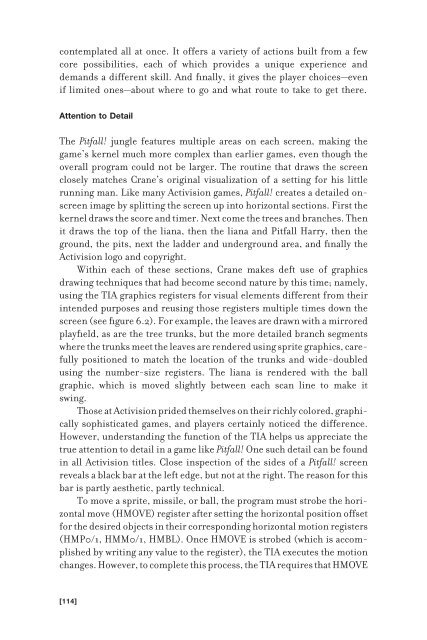Racing the Beam : the Atari Video Computer System - Index of
Racing the Beam : the Atari Video Computer System - Index of
Racing the Beam : the Atari Video Computer System - Index of
You also want an ePaper? Increase the reach of your titles
YUMPU automatically turns print PDFs into web optimized ePapers that Google loves.
contemplated all at once. It <strong>of</strong>fers a variety <strong>of</strong> actions built from a few<br />
core possibilities, each <strong>of</strong> which provides a unique experience and<br />
demands a different skill. And fi nally, it gives <strong>the</strong> player choices—even<br />
if limited ones—about where to go and what route to take to get <strong>the</strong>re.<br />
Attention to Detail<br />
The Pitfall! jungle features multiple areas on each screen, making <strong>the</strong><br />
game’s kernel much more complex than earlier games, even though <strong>the</strong><br />
overall program could not be larger. The routine that draws <strong>the</strong> screen<br />
closely matches Crane’s original visualization <strong>of</strong> a setting for his little<br />
running man. Like many Activision games, Pitfall! creates a detailed onscreen<br />
image by splitting <strong>the</strong> screen up into horizontal sections. First <strong>the</strong><br />
kernel draws <strong>the</strong> score and timer. Next come <strong>the</strong> trees and branches. Then<br />
it draws <strong>the</strong> top <strong>of</strong> <strong>the</strong> liana, <strong>the</strong>n <strong>the</strong> liana and Pitfall Harry, <strong>the</strong>n <strong>the</strong><br />
ground, <strong>the</strong> pits, next <strong>the</strong> ladder and underground area, and fi nally <strong>the</strong><br />
Activision logo and copyright.<br />
Within each <strong>of</strong> <strong>the</strong>se sections, Crane makes deft use <strong>of</strong> graphics<br />
drawing techniques that had become second nature by this time; namely,<br />
using <strong>the</strong> TIA graphics registers for visual elements different from <strong>the</strong>ir<br />
intended purposes and reusing those registers multiple times down <strong>the</strong><br />
screen (see fi gure 6.2). For example, <strong>the</strong> leaves are drawn with a mirrored<br />
playfi eld, as are <strong>the</strong> tree trunks, but <strong>the</strong> more detailed branch segments<br />
where <strong>the</strong> trunks meet <strong>the</strong> leaves are rendered using sprite graphics, carefully<br />
positioned to match <strong>the</strong> location <strong>of</strong> <strong>the</strong> trunks and wide-doubled<br />
using <strong>the</strong> number-size registers. The liana is rendered with <strong>the</strong> ball<br />
graphic, which is moved slightly between each scan line to make it<br />
swing.<br />
Those at Activision prided <strong>the</strong>mselves on <strong>the</strong>ir richly colored, graphically<br />
sophisticated games, and players certainly noticed <strong>the</strong> difference.<br />
However, understanding <strong>the</strong> function <strong>of</strong> <strong>the</strong> TIA helps us appreciate <strong>the</strong><br />
true attention to detail in a game like Pitfall! One such detail can be found<br />
in all Activision titles. Close inspection <strong>of</strong> <strong>the</strong> sides <strong>of</strong> a Pitfall! screen<br />
reveals a black bar at <strong>the</strong> left edge, but not at <strong>the</strong> right. The reason for this<br />
bar is partly aes<strong>the</strong>tic, partly technical.<br />
To move a sprite, missile, or ball, <strong>the</strong> program must strobe <strong>the</strong> horizontal<br />
move (HMOVE) register after setting <strong>the</strong> horizontal position <strong>of</strong>fset<br />
for <strong>the</strong> desired objects in <strong>the</strong>ir corresponding horizontal motion registers<br />
(HMP0/1, HMM0/1, HMBL). Once HMOVE is strobed (which is accomplished<br />
by writing any value to <strong>the</strong> register), <strong>the</strong> TIA executes <strong>the</strong> motion<br />
changes. However, to complete this process, <strong>the</strong> TIA requires that HMOVE<br />
[114]


